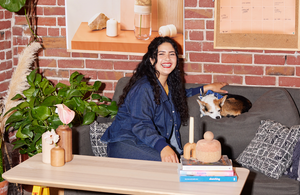Carved Into Memory: an Interview with Melanie Abrantes

Melanie Abrantes checks off a lot of boxes when it comes to makers that we want to work with. Not only does she design beautiful, thoughtful pieces with a lot of heart, but it’s also great knowing that we can help support another BIPOC, woman-owned, Bay Area small business. Not to mention, she’s super fun and just as food obsessed as we are!
Her newest collection of work, Third Culture: Childhood Foods from the Diaspora, explores the foods that Melanie grew up eating influenced by her Filipino and Portuguese heritage. But since she grew up in Texas, Melanie also reminisces about how American foods played a huge part in everyday snacking.
We had the chance to ask Melanie about her art background, wood-carving, and what the future holds for Melanie Abrantes Designs.

Rare Device: What is your art background and how did you choose woodcarving as your craft of choice?
Melanie Abrantes: I went to Otis College of Art and Design to study Product Design. It was a really hands-on program, so I was able to learn how to do woodworking, ceramics, glassblowing and metal working. I fell in love with woodcarving while I was there. It was so satisfying to learn how to manipulate such a hard material like wood into beautiful forms.

RD: What is relief carving? Can you describe the process that went into making these pieces for the show? How long did each one take to carve?
MA: Relief carving is one of the oldest types of carving in existence! It's when you carve a 3-dimensional piece out of a single plane of wood by removing the negative space in the design. In my practice I generally whittle, so I am relatively new to relief carving! But last year I took a class at the Port Townsend School of Woodworking where we learned this technique and I was hooked. Each of the pieces in this show took quite a while to make, ranging from 16-32 hours. That’s the thing about carving, it’s not a process that you can rush. It was difficult but I was so excited to challenge myself with each one!
RD: What are all the mediums you work with and how do certain mediums work better in particular art projects over others?
MA: I’m a woodturner at heart, so most of my work is made with cork and wood. While turning is fun, it has its limitations – you can’t make anything on a lathe that isn’t round. So for me, carving wood is a great way to get more free-form, organic pieces. I have tried to carve cork before, but the material just isn't meant to be cut that way. On a lathe I am cutting at 1000 RPM (really fast!) which makes the cork cut like butter!

RD: Can you tell us more about the house you recently bought in Portugal and what that means for Melanie Abrantes Designs?
MA: Yes! I am so excited for this next venture for my company! Last year we started doing production in Portugal and I purchased this house to make it into a new studio for Melanie Abrantes Designs. It’s under renovation right now but I hope to eventually have a team there plus a showroom for our work. I’m also planning to make a portion of the house a rental so guests can have the full experience! We found an amazing 4-story home in the middle of Porto that had originally been an architect’s studio for the last 40 years. It has a lot of history and character that I want to honor as I make it my own.

RD: I love that the show incorporates your 3 cultures, Portuguese, Filipino, and American. Are there other ways that your work reflects your multi-cultural upbringing?
MA: Well, I was inspired to start working with cork because of my half-Portuguese heritage. 90% of cork comes from Portugal! When I was younger I would visit my grandfather and saw so many cork products. I knew I wanted to work in that material one day! I am a big fan of mixing materials, and I always felt like doing so felt like a little reflection of me! My goal is to one day work in rattan and other Filipino materials too!
RD: I was amazed to see that your online store carried other brands like Moglea and Peaches Studios. What goes into curating your shop and how do you find things that will complement your work?
MA: Yes! We love the idea of including other artists on our site. We are lucky enough to attend shows where we get to meet these designers in real life. I think supporting other small businesses and highlighting what they do make it so our shop can feel more full! We complement our work by seeking artists that have a similar aesthetic and practice, including creating handmade objects and using sustainable materials.
Third Culture: Childhood Foods from the Diaspora is in the Rare Device gallery and website from August 11th until September 17th.

